TPMS Alfa Romeo MiTo 2020 Owner handbook (in English)
[x] Cancel search | Manufacturer: ALFA ROMEO, Model Year: 2020, Model line: MiTo, Model: Alfa Romeo MiTo 2020Pages: 212, PDF Size: 5.18 MB
Page 56 of 212
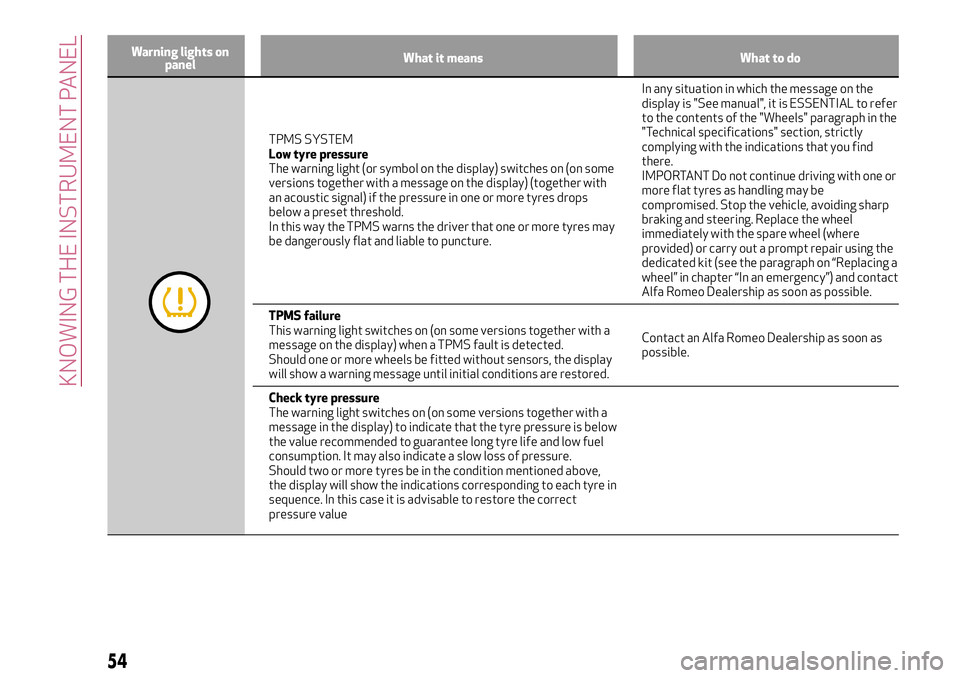
Warning lights on
panelWhat it means What to do
TPMS SYSTEM
Low tyre pressure
The warning light (or symbol on the display) switches on (on some
versions together with a message on the display) (together with
an acoustic signal) if the pressure in one or more tyres drops
below a preset threshold.
In this way the TPMS warns the driver that one or more tyres may
be dangerously flat and liable to puncture.In any situation in which the message on the
display is "See manual", it is ESSENTIAL to refer
to the contents of the "Wheels" paragraph in the
"Technical specifications" section, strictly
complying with the indications that you find
there.
IMPORTANT Do not continue driving with one or
more flat tyres as handling may be
compromised. Stop the vehicle, avoiding sharp
braking and steering. Replace the wheel
immediately with the spare wheel (where
provided) or carry out a prompt repair using the
dedicated kit (see the paragraph on “Replacing a
wheel” in chapter “In an emergency”) and contact
Alfa Romeo Dealership as soon as possible.
TPMS failure
This warning light switches on (on some versions together with a
message on the display) when a TPMS fault is detected.
Should one or more wheels be fitted without sensors, the display
will show a warning message until initial conditions are restored.Contact an Alfa Romeo Dealership as soon as
possible.
Check tyre pressure
The warning light switches on (on some versions together with a
message in the display) to indicate that the tyre pressure is below
the value recommended to guarantee long tyre life and low fuel
consumption. It may also indicate a slow loss of pressure.
Should two or more tyres be in the condition mentioned above,
the display will show the indications corresponding to each tyre in
sequence. In this case it is advisable to restore the correct
pressure value
54
KNOWING THE INSTRUMENT PANEL
Page 67 of 212
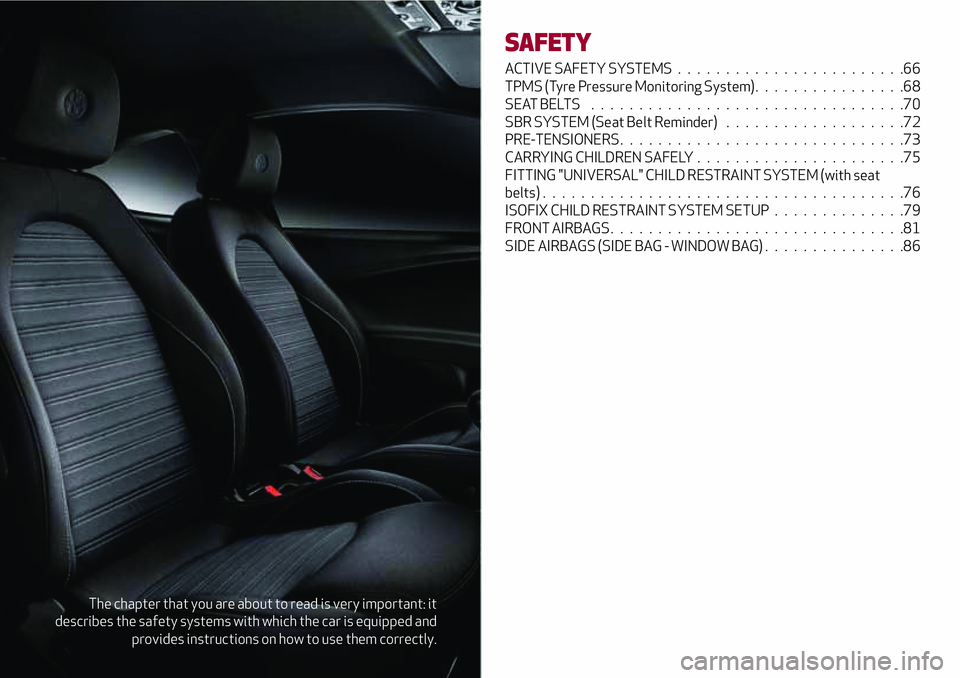
The chapter that you are about to read is very important: it
describes the safety systems with which the car is equipped and
provides instructions on how to use them correctly.
SAFETY
ACTIVE SAFETY SYSTEMS . . . . . . . . ................66
TPMS (Tyre Pressure Monitoring System) ................68
SEATBELTS .................................70
SBR SYSTEM (Seat Belt Reminder) . . . . ...............72
PRE-TENSIONERS . .............................73
CARRYING CHILDREN SAFELY . . . . . .................75
FITTING "UNIVERSAL" CHILD RESTRAINT SYSTEM (with seat
belts)......................................76
ISOFIX CHILD RESTRAINT SYSTEM SETUP . . . . . . . . . . . . . .79
FRONT AIRBAGS . . .............................81
SIDE AIRBAGS (SIDE BAG - WINDOW BAG) . . . . . . .........86
Page 70 of 212
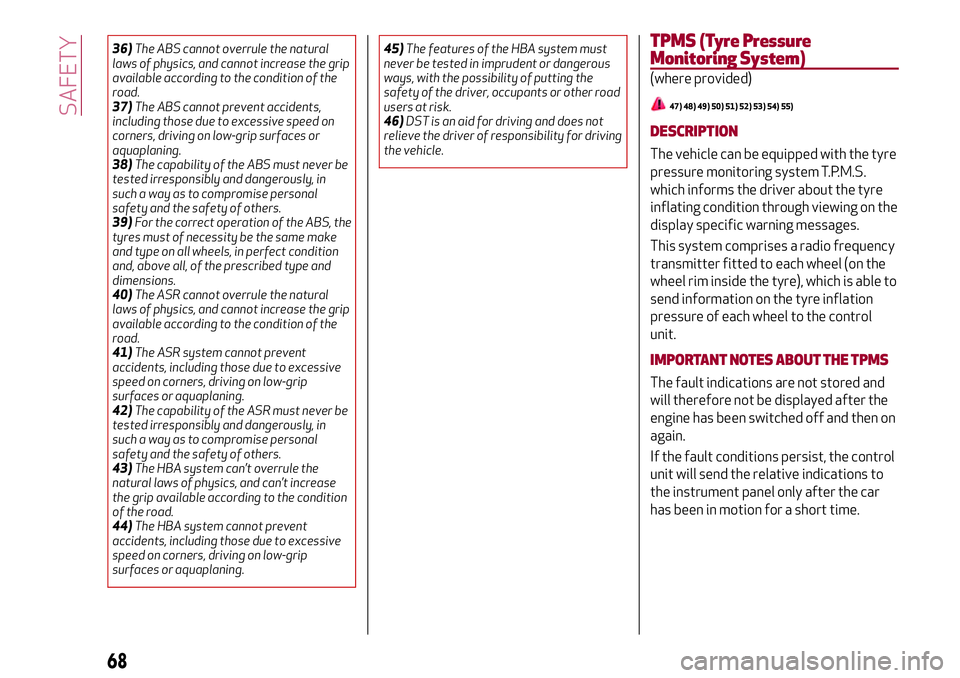
36)The ABS cannot overrule the natural
laws of physics, and cannot increase the grip
available according to the condition of the
road.
37)The ABS cannot prevent accidents,
including those due to excessive speed on
corners, driving on low-grip surfaces or
aquaplaning.
38)The capability of the ABS must never be
tested irresponsibly and dangerously, in
such a way as to compromise personal
safety and the safety of others.
39)For the correct operation of the ABS, the
tyres must of necessity be the same make
and type on all wheels, in perfect condition
and, above all, of the prescribed type and
dimensions.
40)The ASR cannot overrule the natural
laws of physics, and cannot increase the grip
available according to the condition of the
road.
41)The ASR system cannot prevent
accidents, including those due to excessive
speed on corners, driving on low-grip
surfaces or aquaplaning.
42)The capability of the ASR must never be
tested irresponsibly and dangerously, in
such a way as to compromise personal
safety and the safety of others.
43)The HBA system can’t overrule the
natural laws of physics, and can’t increase
the grip available according to the condition
of the road.
44)The HBA system cannot prevent
accidents, including those due to excessive
speed on corners, driving on low-grip
surfaces or aquaplaning.45)The features of the HBA system must
never be tested in imprudent or dangerous
ways, with the possibility of putting the
safety of the driver, occupants or other road
users at risk.
46)DST is an aid for driving and does not
relieve the driver of responsibility for driving
the vehicle.TPMS (Tyre Pressure
Monitoring System)
(where provided)
47) 48) 49) 50) 51) 52) 53) 54) 55)
DESCRIPTION
The vehicle can be equipped with the tyre
pressure monitoring system T.P.M.S.
which informs the driver about the tyre
inflating condition through viewing on the
display specific warning messages.
This system comprises a radio frequency
transmitter fitted to each wheel (on the
wheel rim inside the tyre), which is able to
send information on the tyre inflation
pressure of each wheel to the control
unit.
IMPORTANT NOTES ABOUT THE TPMS
The fault indications are not stored and
will therefore not be displayed after the
engine has been switched off and then on
again.
If the fault conditions persist, the control
unit will send the relative indications to
the instrument panel only after the car
has been in motion for a short time.
68
SAFETY
Page 72 of 212
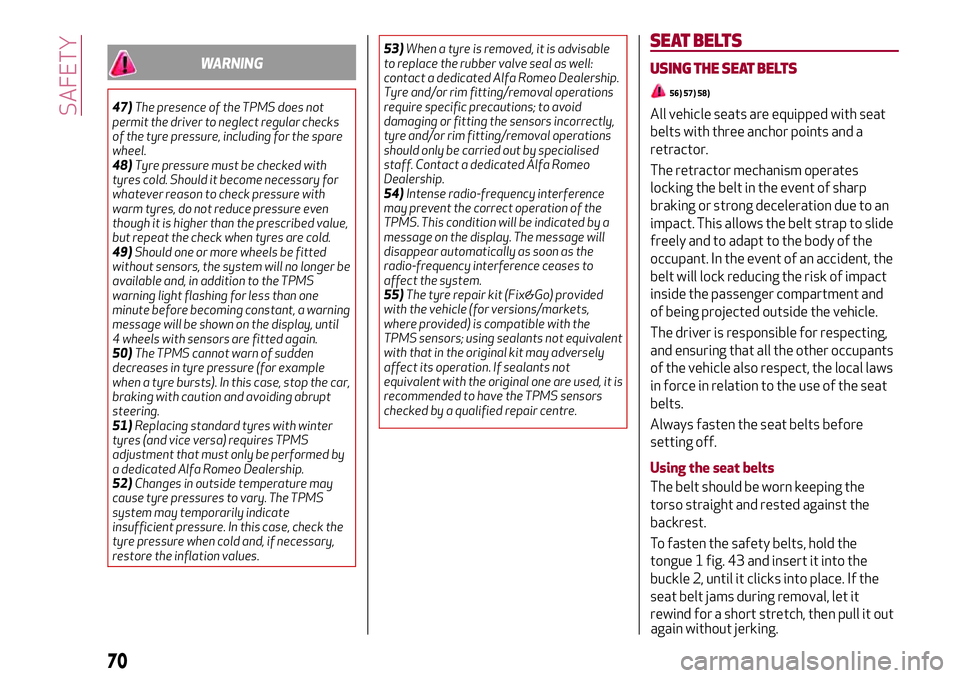
WARNING
47)The presence of the TPMS does not
permit the driver to neglect regular checks
of the tyre pressure, including for the spare
wheel.
48)Tyre pressure must be checked with
tyres cold. Should it become necessary for
whatever reason to check pressure with
warm tyres, do not reduce pressure even
though it is higher than the prescribed value,
but repeat the check when tyres are cold.
49)Should one or more wheels be fitted
without sensors, the system will no longer be
available and, in addition to the TPMS
warning light flashing for less than one
minute before becoming constant, a warning
message will be shown on the display, until
4 wheels with sensors are fitted again.
50)The TPMS cannot warn of sudden
decreases in tyre pressure (for example
when a tyre bursts). In this case, stop the car,
braking with caution and avoiding abrupt
steering.
51)Replacing standard tyres with winter
tyres (and vice versa) requires TPMS
adjustment that must only be performed by
a dedicated Alfa Romeo Dealership.
52)Changes in outside temperature may
cause tyre pressures to vary. The TPMS
system may temporarily indicate
insufficient pressure. In this case, check the
tyre pressure when cold and, if necessary,
restore the inflation values.53)When a tyre is removed, it is advisable
to replace the rubber valve seal as well:
contact a dedicated Alfa Romeo Dealership.
Tyre and/or rim fitting/removal operations
require specific precautions; to avoid
damaging or fitting the sensors incorrectly,
tyre and/or rim fitting/removal operations
should only be carried out by specialised
staff. Contact a dedicated Alfa Romeo
Dealership.
54)Intense radio-frequency interference
may prevent the correct operation of the
TPMS. This condition will be indicated by a
message on the display. The message will
disappear automatically as soon as the
radio-frequency interference ceases to
affect the system.
55)The tyre repair kit (Fix&Go) provided
with the vehicle (for versions/markets,
where provided) is compatible with the
TPMS sensors; using sealants not equivalent
with that in the original kit may adversely
affect its operation. If sealants not
equivalent with the original one are used, it is
recommended to have the TPMS sensors
checked by a qualified repair centre.
SEAT BELTS
USING THE SEAT BELTS
56) 57) 58)
All vehicle seats are equipped with seat
belts with three anchor points and a
retractor.
The retractor mechanism operates
locking the belt in the event of sharp
braking or strong deceleration due to an
impact. This allows the belt strap to slide
freely and to adapt to the body of the
occupant. In the event of an accident, the
belt will lock reducing the risk of impact
inside the passenger compartment and
of being projected outside the vehicle.
The driver is responsible for respecting,
and ensuring that all the other occupants
of the vehicle also respect, the local laws
in force in relation to the use of the seat
belts.
Always fasten the seat belts before
setting off.
Using the seat belts
The belt should be worn keeping the
torso straight and rested against the
backrest.
To fasten the safety belts, hold the
tongue 1 fig. 43 and insert it into the
buckle 2, until it clicks into place. If the
seat belt jams during removal, let it
rewind for a short stretch, then pull it out
70
SAFETY
again without jerking.
Page 116 of 212
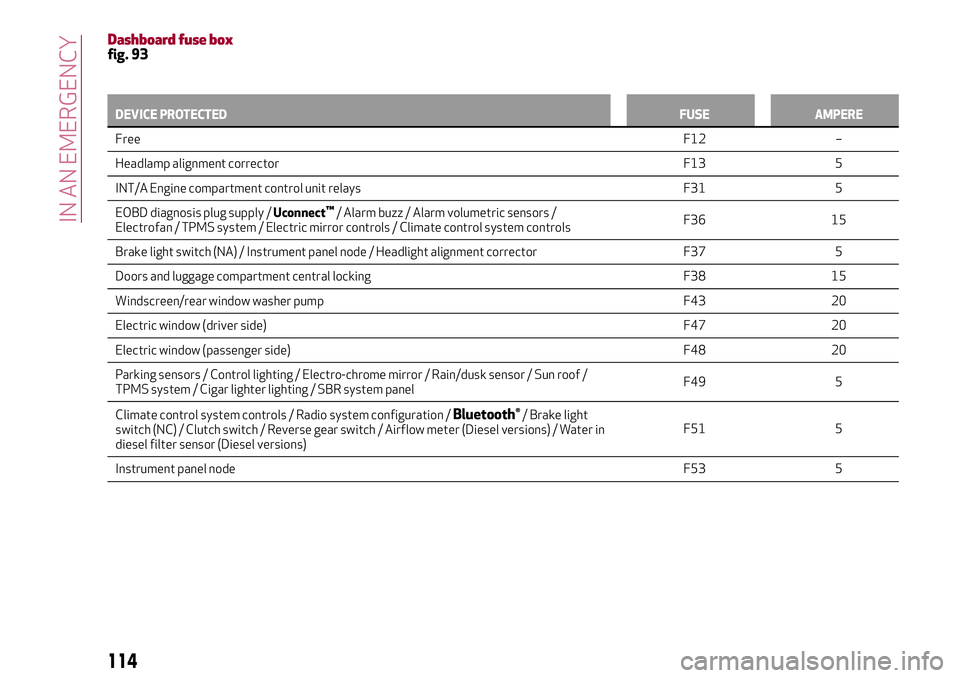
Dashboard fuse boxfig. 93
DEVICE PROTECTEDFUSE AMPERE
FreeF12 –
Headlamp alignment corrector F13 5
INT/A Engine compartment control unit relays F31 5
EOBD diagnosis plug supply /Uconnect
™/ Alarm buzz / Alarm volumetric sensors /
Electrofan / TPMS system / Electric mirror controls / Climate control system controlsF36 15
Brake light switch (NA) / Instrument panel node / Headlight alignment corrector F37 5
Doors and luggage compartment central locking F38 15
Windscreen/rear window washer pump F43 20
Electric window (driver side)F47 20
Electric window (passenger side) F48 20
Parking sensors / Control lighting / Electro-chrome mirror / Rain/dusk sensor / Sun roof /
TPMS system / Cigar lighter lighting / SBR system panelF49 5
Climate control system controls / Radio system configuration /
Bluetooth®/ Brake light
switch (NC) / Clutch switch / Reverse gear switch / Airflow meter (Diesel versions) / Water in
diesel filter sensor (Diesel versions)F51 5
Instrument panel nodeF53 5
114
IN AN EMERGENCY
Page 209 of 212

Third brake lights
bulb replacement...........110
Towing the vehicle............125
Towing trailers...............99
TPMS (Tyre Pressure Monitoring
System)..................68
Trip Computer...............45
Tyres
Fix&Go Automatic (kit).......120Tyres (inflation pressure)........162
Using the manual gearbox........92
Vehicle changes/alterations.......4
Version with LPG system.........36
Warning lights and messages......46
Weights..................166
Wheels...................159
Wheels and tyres
changing a wheel...........116Window bags (side airbags for head
protection) ................86
Windscreen / rear window washing
(fluid level) . . . . . ..........142
Windscreen/rear window wiper . .22 ,144